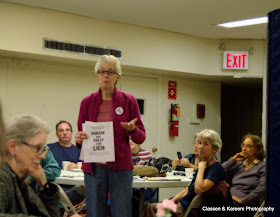October 17, 2014 Citizens Defending Libraries and the First Unitarian Universalist Congregation of Brooklyn’s Weaving the Fabric of Diversity Committee hosted a discussion about the sale of public assets.
The evening began with shared discussion and then broke into group discussions. At the end of the evening the groups shared in discussion the commonality of challenges and threats being faced by the public in different instances . . . public parks and public buildings built on city-owned land, schools, colleges, libraries, fire houses, playgrounds, police stations, hospitals, housing, memorials . . .
 |
| Senator Velmanette Montgomery |
Starter List Identifying Commonalities When Confronting Sale of Public Assets
Discussion of Sale of Public Assets- October 17, 2014
Unitarian Congregation Undercroft, 50 Monroe Place, Brooklyn, NY 11201
In various areas the public and its watchdogs are confronted by tactics such as the following when public assets are besieged and handed off for sale (help us identify other characteristically common aspects of the threats faced):
1. Deliberate underfunding of targeted assets running them into the ground, deteriorating them and driving away their constituencies.Below in basic outline form some other topics emerging from discussion.
2. Manufacturing crisis conditions and seeking to promote a "TINA" narrative ("There Is No Alternative"). This can include overestimating or otherwise inflating repair and maintenance costs.
3. Opportunistically taking advantage of income inequality- Picking on and going after assets that have more value to a less advantaged and less politically powerful population than they do to those members of the population with greater influence. Beneficiaries of these plans tend to be .01% rather than other New Yorkers.
4. Underestimate the value of the assets to the public. As in the example of the sale of the Donnell library, this may result in assets being disposed of at far less than their true value.
5. Do top-down designed deals that the public will be the last to know about, part of a general effort to eliminate the public from discussions to the maximum extent possible.
6. Stacking decision-making boards with people who are unsympathetic to those served by the targeted assets.
7. Rush deals through (especially, as we have seen recently, at the end of the Bloomberg administration).
8. Dismiss alternatives to protect and preserve the assets. (Includes obfuscating and ignoring better alternative courses of action, minimizing the downside of asset sales while exaggerating expected benefits while PR expenditures seek to capture the press and lobbying and campaign money is spent to win over public officials.
FUTURE STRUCTURAL NEXT STEPS?
1. Wealth (+Political) inequality
a. Diminished commonality/sympathy
b. Goals not shared (most goals that succeed politically have backing from a high percentage of the wealthy)
c. Reduced taxes diverting and diminishing funds
d. Taking unfair advantage of tilted playing field
2. Money in politics
a. Fair elections
b. Ethics and conflicts laws
c. Bulwarks for asset protection
3. Keeping public purpose entities on mission (pull of money a problem)
4. Common narrative
5. Too many simultaneous battles- divide and conquer tactic, plus it taxes our attention and effort if nothing else.
6. Press and Media (pull of money and ownership a problem)
7. Lawyers and law (absence of and lopsidedness of money a problem)
8. Develop what other infrastructure for common use? (Doesn’t have to be expensive)
9. Same characters- The same political players and operatives overlap, popping up repeatedly in attacks on different public assets.

.jpg)



.JPG)




.JPG)






.JPG)

No comments:
Post a Comment